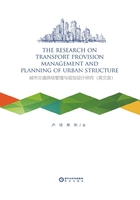
2.4 Chapter Discussion
There is a“struggle”between strategic planning in urban planning and local planning and free development. This is not just a legacy of the modernist master plan versus postmodernism. New traditional urbanism may contain its own strict rules. However, the focus of the“post-modern”settlement structure is that its main structural elements are the same as those of the“modern”era. Both modern and post-modern settlements can use the main road network as the main structural basis, or use public transport as the main spine structural element. The difference is mainly in the details: although modern settlements may extend the hierarchical layout to the lowest level, post-modern settlements may break down this detail to provide the grid hybrid street on a local scale. That means that even if walking is more attractive for short trips in this new traditional enclave, the main means of transport around the settlements could still be cars. If the enclave remains structurally and conceptually a“pod”attached to the transport superstructure, then the superstructure is road-based, and road travel will remain superior. So the new traditional layouts may solve some local problems by creating some walkable urban enclaves, but if they are simply added to the modernist superstructure, they will behave like modern settlements on a macro level. In our actual planning, postmodern or new traditional design hopes to combine the other three design methods: sometimes classical(or neoclassical)grid, sometimes organic(or pseudo-organic)grid“village”, all attached to the“modern”superstructure. Perhaps the true organic model is closely related to the casual urban life espoused by the new traditional urbanism. However, the design of postmodernism may be more similar to what they reject (modernism)than what they want to imitate(organic).
The chapter shows the extent to which transport can be seen as“key”to the city's structure. This is not only because of the inherent continuity of the transportation network, the construction, functions and activities of urban areas are inseparable from the transportation network. This means that from a planner's perspective, the line network is not just something left to the transport professionals: it can serve as the basis for the urban planner's structure to be used and utilized in the construction of settlements.
We have seen four broad“structural types”that show the different ways traffic structures are expressed in the creation of urban structures. Although these represent, to some extent, successive stages of development, it is possible to return to the classical or original form, perhaps even encouraged under the umbrella of post-modernism.
From the perspective of modernism in the process of transportation and supply in urban design, and the existing planning results, it can be seen that the adoption of the modernist hierarchy not only destroys the integration of cities, but also promotes the formation of new urban layout structures by suppressing traditional urban streets and street layouts. Post-modernism seems to have adopted a more integrated approach, promoting the development of traditional streets and encouraging collage between tradition and new tradition. However, postmodernism seems to follow the structural logic similar to modernism, and its diversity and integrity only appear in local scale or surface details. And the disciplines that affect traffic planning and traffic engineering are also stuck in the modernist paradigm, which is based on the efficiency of movement and has been abandoned by the public.
In fact, we do not have enough theory to support the establishment of postmodernism, which deserves further discussion.
In fact, it is important to consider the issues raised by modernism and postmodernism, as they seem to go to the heart of the issue of transportation planning. We can see how the modernist concepts of zoning, isolation, functional circulation, road hierarchy and open planning fit together well and with consistent logic, although these may be related to the failure of urban planning.
Whether the various parts of the modernist edifice can exist independently, however, is not necessarily clear whether they are replaced or simply inserted. At the same time, no matter what kind of ambiguity exists in theory, measures are finally taken in practice to correct the balance of design development towards more traditional urban forms and go hand in hand with more traditional and sustainable traffic forms. These methods seem to represent the most clearly expressed design intention of our study.